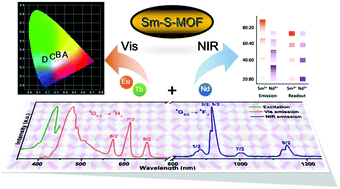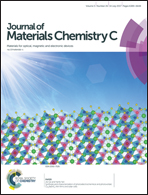Luminescence of samarium(iii) bis-dithiocarbamate frameworks: codoped lanthanide emitters that cover visible and near-infrared domains†
Abstract
Metal–organic frameworks constructed from lanthanides and organic linkers with oxygen or/and nitrogen donors (LnMOFs) are a very promising class of materials for various luminescence applications. However, the utilization of sulphur-donor ligands for sensitizing the luminescence of lanthanide ions is still hampered. Herein, a series of three-dimensional (3D) isostructural open frameworks: (H3O)[Ln(pipzdtc)2]·1.5(H2O)·2.5(CH3NO) (Ln3+ = Ce3+, Nd3+, Sm3+, Eu3+, Gd3+, and Tb3+, pipzdtc = piperazine-1,4-dicarbodithiolate) (Ln-S-MOFs) are synthesized. The Sm-S-MOF shows emission bands that range from the visible to the near-infrared (NIR) regions. The characteristic emission bands of Ln-S-MOFs (Ln = Ce3+, Eu3+, Gd3+ and Tb3+) cannot be observed. The isomorphous mixed-Sm-S-MOFs: Sm1−xEux-S-MOFs, Sm1−yTby-S-MOFs, Sm1−x−yEuxTby-S-MOFs, and Sm1−zNdz-S-MOFs are synthesized via in situ doping. In the visible region, the color of the luminescence can be systematically modulated, and white light emission can be successfully achieved. Significantly, the Sm1−zNdz-S-MOFs show sharp NIR signals of both Sm3+ and Nd3+ centers. The NIR emission intensity ratios of Sm3+ and Nd3+ are almost linearly related to their atomic ratios. This work is a significant step forward towards versatile, easily prepared luminescent Ln-S-MOFs suitable for practical applications including white light emission, and especially for NIR luminescent barcodes obtained from a single framework.



 Please wait while we load your content...
Please wait while we load your content...